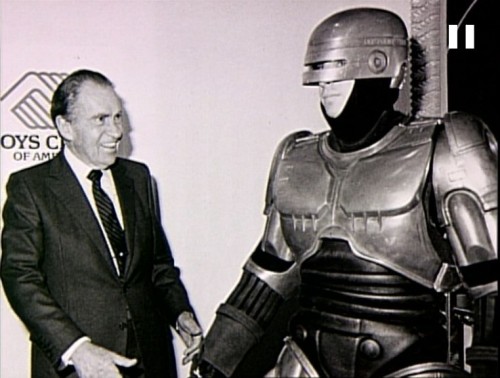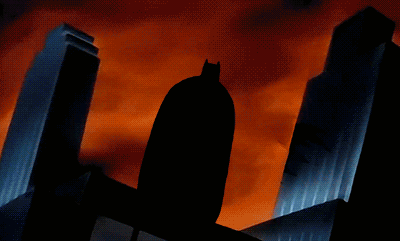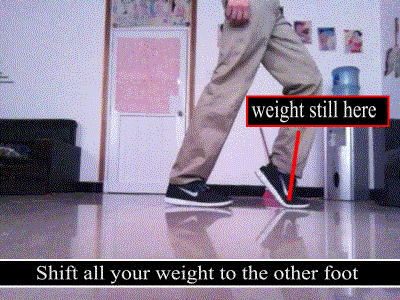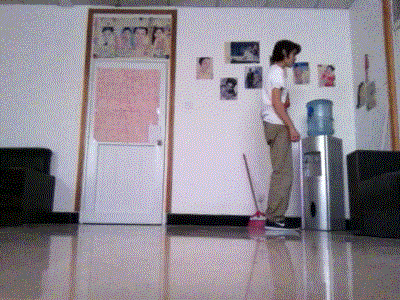Submitted by: Unknown
Shared posts
Kim Dotcom's Mega now accepts Bitcoins
In an announcement, Dotcom called Mega "The Privacy Company."
I tell girls I model. It's not a total lie, but they're usually disappointed.
Quadrin 18/02/2013 - Níquel Náusea (Fernando Gonsales)
| Níquel Náusea | Fernando Gonsales |
 | |
What 200 calories looks like in various foods
Submitted by: thatiscool
Posted at: 2013-02-18 03:08:00
See full post and comment: http://9gag.com/gag/6610885
Obama to announce decade-long, multi-billion, brain mapping project, seeking to do for the brain what the Human Genome Project did for genetics.
awesomepeoplehangingouttogether: Richard Nixon and Robocop
“It does no harm to the romance of the sunset to know a little bit about it.” -Carl Sagan
Happy Birthday, Pale Blue Dot: A Timeless Valentine to the Cosmos
“The Earth is a very small stage in a vast cosmic arena.”
On this day in 1990, the Voyager 1 spacecraft — which carried The Golden Record, Carl Sagan’s love letter to Annie Druyan — turned its revolutionary camera around and took the iconic “Pale Blue Dot” photograph that later inspired the famous Sagan monologue of the same title. The image, composed of 640,000 individual pixels, depicts Earth, a mere 12% of a single pixel, at the center of a scattered ray of light resulting from taking an image this close to the Sun. It endures, even in an age when the future of space exploration hangs in precarious balance, as a timeless Valentine to the cosmos.
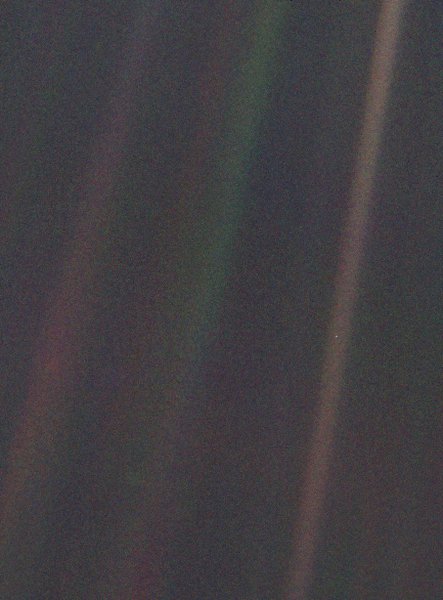
The Pale Blue Dot: Captured from 3.7 billion miles away, Earth appears as a tiny dot halfway down the orange stripe on the right.
Image: NASA / JPL
The “Pale Blue Dot” was part of a Family Portrait series of images exploring the Solar System.
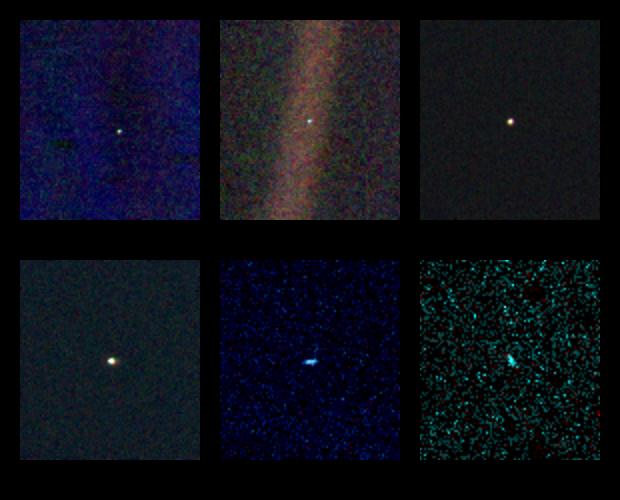
The Family Portrait: These six narrow-angle color images were made from the first ever 'portrait' of the Solar System taken by Voyager 1 at 3.7 billion miles from Earth and about 32 degrees above the ecliptic. The spacecraft acquired a total of 60 frames for a mosaic of the solar system which shows six of the planets. Mercury is too close to the sun to be seen. Mars was not detectable by the Voyager cameras due to scattered sunlight in the optics, and Pluto was not included in the mosaic because of its small size and distance from the sun. These blown-up images, left to right and top to bottom are Venus, Earth, Jupiter, and Saturn, Uranus, Neptune.
Image: NASA / JPL
But we owe the actual recognition of Earth in the legendary photograph to Candice Hansen-Koharcheck, one of the two University of Arizona scientists who developed the command sequence that controlled the timing for each photograph’s exposure. That day, she was sitting in front of a computer at NASA’s Jet Propulsion Lab with her shades drawn when she noticed the tiny speck on an image sent back by the camera she had helped design, which was now 4 billion miles away. She told NPR a few years ago:
It was just a little dot, about two pixels big, three pixels big, so not very large. … You know, I still get chills down my back because here was our planet, bathed in this ray of light, and it just looked incredibly special.
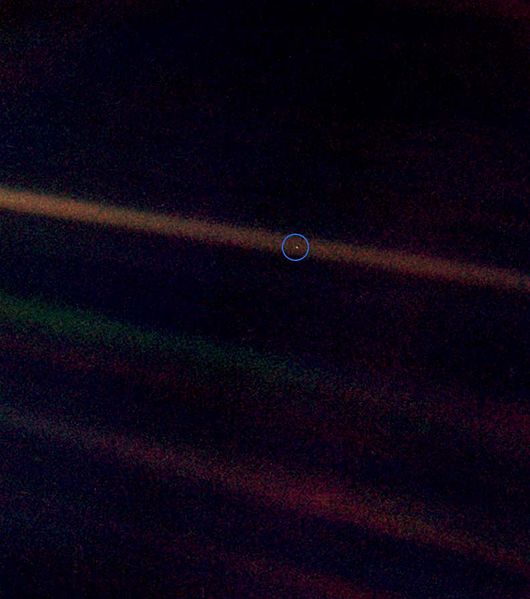
The Pale Blue Dot: This blown-up image of the Earth was taken through three color filters -- violet, blue and green -- and recombined to produce the color image. The background features in the image are artifacts resulting from the magnification.
Image: NASA / JPL
And yet photograph almost never happened — the NASA imaging team feared that aiming the camera at the Sun would damage it. But Sagan himself lobbied long and hard for an attempt. Vice Adm. Richard Truly, former head of NASA, recalls:
I did get a visit from Carl Sagan. We talked about a lot of things. And somewhere in that conversation he mentioned this idea. I thought, heck, with Voyager so far away, if it could turn around and take a picture of the different planets including the Earth, that that would really be cool. And so I was a great advocate of it, although I can’t take any credit for it.
(Those were the golden days when NASA made historic decisions simply because something seemed “cool.”)
Fortunately, it did happen. And four years later, Carl Sagan wrote of the iconic image in the preface to his book titled after it, Pale Blue Dot: A Vision of the Human Future in Space (public library):
From this distant vantage point, the Earth might not seem of any particular interest. But for us, it’s different. Consider again that dot. That’s here. That’s home. That’s us. On it everyone you love, everyone you know, everyone you ever heard of, every human being who ever was, lived out their lives. The aggregate of our joy and suffering, thousands of confident religions, ideologies, and economic doctrines, every hunter and forager, every hero and coward, every creator and destroyer of civilization, every king and peasant, every young couple in love, every mother and father, hopeful child, inventor and explorer, every teacher of morals, every corrupt politician, every ‘superstar,’ every ‘supreme leader,’ every saint and sinner in the history of our species lived there — on a mote of dust suspended in a sunbeam.
The Earth is a very small stage in a vast cosmic arena. Think of the rivers of blood spilled by all those generals and emperors so that in glory and triumph they could become the momentary masters of a fraction of a dot. Think of the endless cruelties visited by the inhabitants of one corner of this pixel on the scarcely distinguishable inhabitants of some other corner. How frequent their misunderstandings, how eager they are to kill one another, how fervent their hatreds. Our posturings, our imagined self-importance, the delusion that we have some privileged position in the universe, are challenged by this point of pale light. Our planet is a lonely speck in the great enveloping cosmic dark. In our obscurity — in all this vastness — there is no hint that help will come from elsewhere to save us from ourselves.
The Earth is the only world known, so far, to harbor life. There is nowhere else, at least in the near future, to which our species could migrate. Visit, yes. Settle, not yet. Like it or not, for the moment, the Earth is where we make our stand. It has been said that astronomy is a humbling and character-building experience. There is perhaps no better demonstration of the folly of human conceits than this distant image of our tiny world. To me, it underscores our responsibility to deal more kindly with one another and to preserve and cherish the pale blue dot, the only home we’ve ever known.

Earthrise, December 24, 1968
Image: NASA
But Sagan’s beautiful and timeless words might not be entirely his own — perhaps a manifestation of neurologist Oliver Sacks’s insights on memory and (inadvertent) plagiarism. As historian Robert Poole notes in Earthrise: How Man First Saw the Earth (public library), after the equally iconic Apollo 8 “Earthrise” photograph made its debut in 1968, the poet Archibald MacLeish penned an essay ‘Riders on the Earth,’ in which he articulated a strikingly similar sentiment:
For the first time in all of time, men have seen the Earth. Seen it not as continents or oceans from the little distance of a hundred miles or two or three, but seen it from the depths of space; seen it whole and round and beautiful and small… To see the Earth as it truly is, small and blue and beautiful in that eternal silence where it floats, is to see ourselves as riders on the Earth together, brothers on that bright loveliness in the eternal cold—brothers who know that they are truly brothers.
The essay appeared in The New York Times on Christmas Day that year.
Then again, the similarity in language might simply be an inevitable expression of the overview effect. Whatever the case, the “Pale Blue Dot” endures as a sublimely beautiful cosmic Valentine that reminds us, more than two decades later, of the ineffable relativity of our human scale.
Celebrate the “Pale Blue Dot” and its legacy with some stunning animated adaptations of Sagan’s words.
Donating = Loving
Bringing you (ad-free) Brain Pickings takes hundreds of hours each month. If you find any joy and stimulation here, please consider becoming a Supporting Member with a recurring monthly donation of your choosing, between a cup of tea and a good dinner:
| ♥ $7 / month♥ $3 / month♥ $10 / month♥ $25 / month |
![]()
You can also become a one-time patron with a single donation in any amount:
 Brain Pickings has a free weekly newsletter and people say it’s cool. It comes out on Sundays and offers the week’s best articles. Here’s what to expect. Like? Sign up.
Brain Pickings has a free weekly newsletter and people say it’s cool. It comes out on Sundays and offers the week’s best articles. Here’s what to expect. Like? Sign up.
Brain Pickings takes 450+ hours a month to curate and edit across the different platforms, and remains banner-free. If it brings you any joy and inspiration, please consider a modest donation – it lets me know I'm doing something right.

“My heart is stronger now that you’re in it”


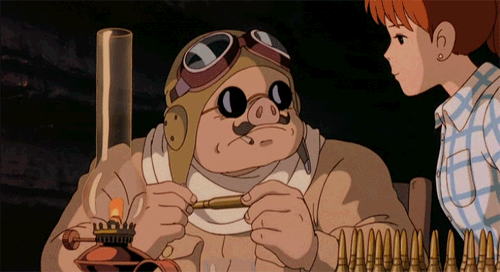
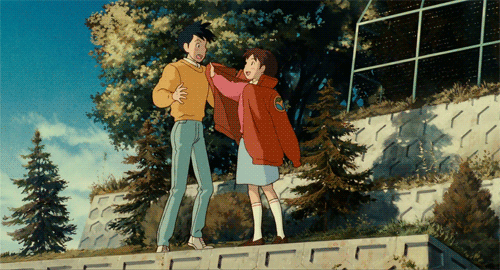
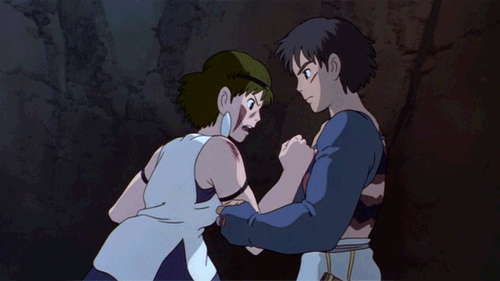
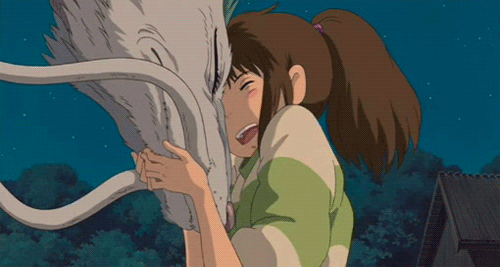

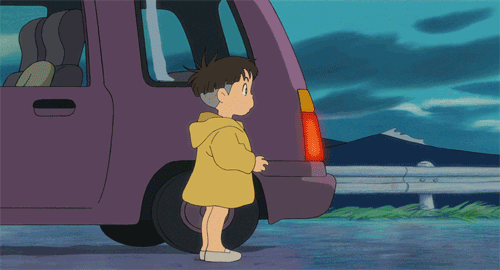
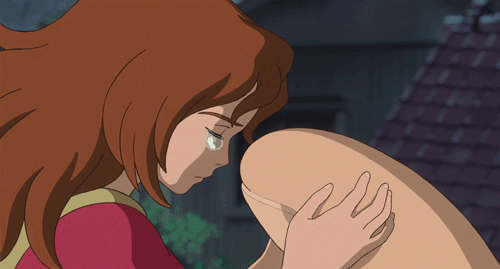
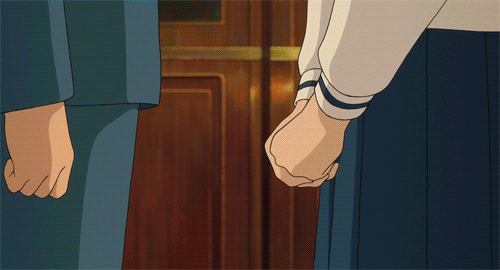
“My heart is stronger now that you’re in it”
Kids Use Coding Skills to Hack Online Games


 Kids as young as 11 are using coding skills to hack accounts on social media and gaming sites, according to one report. Antivirus firm AVG says children are writing malware to steal data and virtual currency from friends.
Kids as young as 11 are using coding skills to hack accounts on social media and gaming sites, according to one report. Antivirus firm AVG says children are writing malware to steal data and virtual currency from friends.
However, the hacks are still in their infancy, as researchers found errors that trace back to the original source. One author included his exact email address, password and additional information, revealing an 11-year-old boy in Canada. Most programming languages researchers found in the study were elementary, such as C# and Visual Basic. Check out the video, above, for more.
SEE ALSO: First Grader Becomes Youngest Person to Ever Develop a Mobile Game
As today's…
Continue reading...
More About: bc video lead, brightcove, Children, coding, hackers, hacking, online gaming, technology, Video
How to Actually Act Like a Local When Traveling
 We hear it all the time in travel advice: do what the locals do. It's fantastic advice, but if you're in an unfamiliar city it's a lot easier said than done. Thankfully, with a little preparation (or on-the-fly Google skills), it's entirely possible to experience a city just like the locals. More »
We hear it all the time in travel advice: do what the locals do. It's fantastic advice, but if you're in an unfamiliar city it's a lot easier said than done. Thankfully, with a little preparation (or on-the-fly Google skills), it's entirely possible to experience a city just like the locals. More » Bento XVI: o lado B
A justificativa mais ampla para o menos lisonjeiro dos títulos veio a público há quase dois anos, quando advogados ligados à causa dos direitos humanos apresentaram uma denúncia contra Bento XVI no Tribunal Penal Internacional, (TPI), em Haia. E em 2010, o jurista britânico Geoffrey Robertson já havia publicado o livro The Case of the Pope: Vatican Accountability for Human Rights Abuse
"Não existe dúvida de que a escala do escândalo de abuso sexual só foi atingida porque diretrizes do Vaticano -- especificamente, da Congregação para a Doutrina da Fé -- exigiam que todas as queixas de abuso sexual fossem processadas em absoluto segredo e escondidas da polícia e das cortes, sob uma Lei Canônica que era obsoleta e não-punitiva", escreve Robertson.
Em pelo menos um caso, o do padre Lawrence Murphy -- acusado de molestar cerca de 200 meninos deficientes auditivos -- o então cardeal Ratzinger foi informado, por carta, dos abusos, mas nada fez a respeito. O Vaticano defende-se dizendo que as cartas chegaram décadas depois de os crimes terem sido cometidos. Ainda assim, a ausência de qualquer tipo de reação ou resposta é intrigante.
Sua atuação como papa também não foi muito melhor que a de inquisidor, ainda que tenha envolvido algum esforço de relações públicas: como a punição de Marcial Maciel, o maníaco sexual fundador dos Legionários de Cristo, cuja carreira de crimes foi absurdamente relevada por João Paulo II. No entanto, a queda de Maciel, sob Bento XVI, foi um caso típico de "gato fora do saco": veio tarde demais, quando o escândalo já era de domínio público e o culpado se encontrava quase à beira da morte.
Criticamente, a norma De gravioribus delictus, editada no reinado de Bento XVI, em 2010, não exige que bispos que tenham conhecimento de atos criminosos praticados por padres os denunciem à polícia, mas apenas à Congregação para a Doutrina da Fé. De fato, o Vaticano chegou a publicar, depois de muita pressão, uma "sugestão" de que os bispos procurassem as autoridades civis, mas ela não foi incorporada à norma. Sugestões à parte, a lei da Igreja segue exigindo "o segredo dos julgamentos, para preservar a dignidade dos envolvidos".
A ONG americana Survivors Network of those Abused by Priests (SNAP) emitiu uma nota sobre a renúncia de Ratzinger, também largamente ignorada pela imprensa. A SNAP oferece, a meu ver, o melhor resumo do pontificado de Bento XVI, tanto sob o ponto de vista teológico quanto moral: "Bento deixa uma Igreja ainda regida por leis sob as quais (...) não se pode ser casado e padre, nem mulher e padre, mas pode-se ser um estuprador de crianças e padre".
All You Have to Do Is Say "Hello"
Submitted by: Unknown (via Zen Pencils)
Tagged: hello , comics , inspirational , zen pencils , dating fails , g rated Share on Facebooksellingstories: Newcastle Brown Ale - Who uses the word...

Newcastle Brown Ale - Who uses the word “chalice”? (Droga5)
Newcastle Brown Ale takes the piss out of Stella Artois’ “It’s a chalice, not a glass” campaign. This is one of the best media buys I have ever seen.
So... the popularity graph for the name "Bruce" looks just like Batman
The DeanBeat: After Zynga’s crash, game investments dive 42 percent in 2012
[For a view on gaming investing myths, read this guest post from YetiZen CEO Sana Choudary. -Ed.]
In 2012, investors were excited about the game market’s march toward billions of new users with the rise of smartphones and tablets. But that excitement fizzled as Zynga’s fortunes wavered, and it reported weak earnings starting in August. Consequently, game investments rose dramatically for a while, and then they tapered off.
The data for this story comes from GamesBeat’s own original research into fundings during the year,with contributions from Sana Choudary of YetiZen, Tim Merel of Digi-Capital,Internet Deal Book, Signia Venture Partners, and Electronic Arts.
The upshot is that game investors have been spooked and they aren’t making as many deals as they once were. That means that higher-quality startups will receive funding, but copycat ideas aren’t necessarily going to. And as weak as the year was in investments, nobody is changing any forecasts about the march of gaming into the stratosphere in revenues and player numbers over time. So the industry is facing a confidence contradiction. Game companies are growing, but the money they’re raising isn’t.

The number of game investments rose to 188 deals, compared to 145 a year ago. But the value of the announced deals was $901.3 million, compared with $1.540 billion in 2011. That represents a 29 percent increase in the number of deals, but a 42 percent decline in dollars invested.
By comparison, the value of game acquisitions rose 23 percent in 2012 to $3.47 billion, compared to $2.87 billion a year earlier. The number of game acquisitions fell from 77 in 2011 to 58 in 2012. According to Avista Partners, the value of publicly traded video game companies is about $153 billion, but 78 percent of the value is in the top 10 companies, with China’s Tencent leading the list.
A big gap exists in investor thinking, according to analyst Peter Warman of Newzooin a recent interview with GamesBeat. Fear kept investors from pouring money into a sector that was actually producing much better results in terms of cashing out through acquisitions. Since 1997, Avista Partners says that games have produced $44 billion in value for venture capitalists and private equity investors since 1997.
Tim Merel, the managing director at Digi-Capital, said that the collapse of social gaming investments in the wake of Zynga’s troubles accounts for almost all of the decline in the game investment deals. Investment capital continued to shift from traditional console games to social, mobile, and online games.
But the clear bright spot for the year was mobile gaming. Merel reported that mobile deals account for as many as 40 percent of the overall game deals. But a mobile game studio with 10 employees can produce a game and get it into the market. It doesn’t need the same kind of capital that earlier game startups required, so it makes sense that the average size of a game deal is getting smaller.
In 2012, the average size was $4.8 million, compared with $10.6 million a year earlier. Zynga’s crash in the stock market (it’s trading at 25 percent of its peak value) also deflated game investment valuations.
Another savior for many game companies was Kickstarter, the crowdfunding platform that raised $83.1 million for video games and board games from 520,000 backers (we’ve included Kickstarter deals in our list). Of that amount, $55 million went to 296 video game companies (we haven’t included most of those on our list). The average amount raised via crowdfunding was $186,000, as most projects raised money for games instead of trying to finance whole companies.
More than anything, Kickstarter changed the dependence of developers on major publishers for funding. Midsized game companies such as Double Fine Productions, which started a Kickstarter mania back in March, could turn directly to their fans for the first time to raise money to make games. The crowdfunding platform became an important place to test disruptive ideas such as the Oculus VR virtual reality goggles and the Ouya Android video game console for televisions.
Certain sectors saw a boom, as hardcore game companies such as Kabam and Kixeye saw huge demand for free-to-play hardcore games. And social casino games debuted by the dozens on Facebook and mobile game platforms.More disruptions are happening as game companies adopt new business models such as free-to-play games, where you play for free and pay small amounts for virtual goods.Gaming also has its own version of the war for talent as big companies acquire smaller ones. Green Throttle Games raised $6 million on the hope that its Android game controller and app could disrupt $60 console games on the television. Such trends serve as grist for the bigger investments.
Signia Ventures (which did eight deals in games in 2012) noted that about 80 percent of investments in 2012 were in North America, with a lot of excitement continuing in mobile gaming, analytics, distribution and the larger consumer mobile ecosystem.
Investors probably shied away from the sector because of the almost total absence of initial public offerings. China’s YY and Zattikka staged a couple of small IPOs, but no one grabbed the attention or the investment dollars like Zynga and Nexon did in 2011, when both companies raised $1 billion each. Zynga raised $515 million in a secondary offering not long before its stock collapsed. And Tencent completed a $598 million fixed income offering. If the IPOs return, you can bet that the investors will as well. But perhaps the only trend to count on is further consolidation with a continued acquisition boom.
Here’s a cautionary note about these numbers. Ifwe knew the value of every deal, the numbers would be much higher this year. We’d love to know how much money Tencent invested in Epic Games, but we don’t. But we have the same problem every year as the majority of the dealmakers keep their values secret.
Heres a look at the deals of the year below. Weve organized them by dollar value of the transactions. For those deals where the value is unknown, we have listed them in reverse chronological order. We have linked to our own VentureBeat/GamesBeat stories where we covered them. For deals we didnt cover, we have linked to other publications or press releases.
The total game investment number for 2010 was $1.05 billion raised by 91 companies, based on GamesBeat’s own research. By comparison,115 game companies raised a total of $663.1 million in 2009. And in 2008,112 game companies raised $936.8 million.Major VC firms such as Accel Partners, Sequoia Capital, DCM, Kleiner Perkins Caufield & Byers,Andreessen Horowitz, and others all poured money into big game companies this year. Google Ventures continued its role as an active strategic investor. Check out the GamesBeat game investments list in the following pages.
Filed under: Games, Mobile, Social, VentureBeat
Those people
At a recent seminar, a woman who helps run a community college stood up to ask a question.
"Well, the bad news," she said, "is that we have to let everyone in. And the truth is, many of these kids just can't be the leaders you're describing, can't make art. We need people to do manual work, and it's those people."
I couldn't believe it. I was speechless, then heartbroken. All I could think of was these young adults, trusting this woman to lead them, teach them, inspire them and push them, and instead being turned into 'those people.'
You know, the people who will flip burgers or sweep streets or fill out forms all day. The ones who will be brainwashed into going into debt, into buying more than they can afford, to living lives that quietly move from one assigned task or one debt payment to another. If they're lucky.
No, I said to her, trying to control my voice, no these are not those people. Not if you don't want them to be.
Everyone is capable of being generous, at least once. Everyone is capable of being original, inspiring and connected, at least once. And everyone is capable of leading, yes, even more than once.
When those that we've chosen to teach and lead write off people because of what they look like or where they live or who their parents are, it's a tragedy. Worse, we often write people off merely because they've been brainwashed into thinking that they have no ability to do more than they've been assigned. Well, if we brainwashed them into setting limits, I know we can teach them to ignore those limits.
PSA How to ACTUALLY moonwalk the proper way. (via ronenreblogs
February 12, 2013

Only 10 days to go on The Science Kickstarter!
And speaking of science... did you catch me and Kelly's story on Story Collider?
This image shows oil-flow visualization of a cylindrical...

This image shows oil-flow visualization of a cylindrical roughness element on a flat plate in supersonic flow. The flow direction is from left to right. In this technique, a thin layer of high-viscosity oil is painted over the surface and dusted with green fluorescent powder. Once the supersonic tunnel is started, the model gets injected in the flow for a few seconds, then retracted. After the run, ultraviolet lighting illuminates the fluorescent powder, allowing researchers to see how air flowed over the surface. Image (a) shows the flat plate without roughness; there is relatively little variation in the oil distribution. Image (b) includes a 1-mm high, 4-mm wide cylinder. Note bow-shaped disruption upstream of the roughness and the lines of alternating light and dark areas that wrap around the roughness and stretch downstream. These lines form where oil has been moved from one region and concentrated in another, usually due to vortices in the roughness wake. Image (c) shows the same behavior amplified yet further by the 4-mm high, 4-mm wide cylinder that sticks up well beyond the edge of the boundary layer. Such images, combined with other methods of flow visualization, help scientists piece together the structures that form due to surface roughness and how these affect downstream flow on vehicles like the Orion capsule during atmospheric re-entry. (Photo credit: P. Danehy et al./NASA Langley #)

